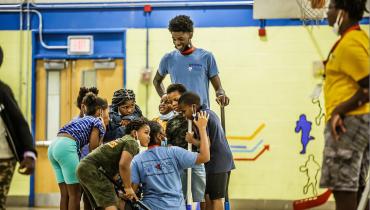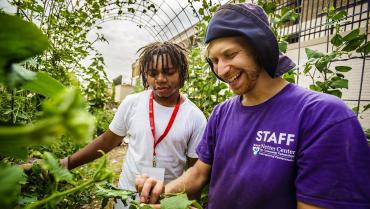We already know community schools work. Children whose families are more connected to their schools—through wraparound services like dental and vision care, food banks and social workers, but more importantly through strong, caring relationships with educators and staff—do better socially, emotionally and academically. Community schools also help address inequity and provide levers for low-income families to engage with school culture and community.
With our history of social responsibility, it is no surprise that the AFT has a long record of supporting community schools. This year, that commitment takes on new meaning with our pledge to reach 2,500 AFT-represented community schools by 2025. That goal parallels the 25,000 schools the Coalition for Community Schools, a part of the Institute for Educational Leadership, has pledged by 2025.
“We’ve been at this for a long time,” said AFT President Randi Weingarten at a recent community schools intensive June 5-6. “So many of the things we talk about in education can be solved by community schools. We no longer have to convince people about the ‘why do it.’ We have to figure out ‘how.’”
That’s why the AFT joined with the Coalition for Community Schools and the Netter Center for Community Partnerships to invite educators and administrators to come together in school district teams, then hammer out ways to move forward—some to launch new community schools and others to expand or improve existing systems. The intensive/workshop preceded the biggest community school event of the year—the Coalition for Community Schools’ National Conference for Community Schools and Family Engagement in Philadelphia June 7-9.
“What you are doing today, you are developing the muscle of the democratization process,” Weingarten told participants. “Listening to each other and then saying, OK, can we get to an agreement? What’s the first step? What’s the second step?”
The intensive offered tools to analyze and plan together according to each team’s unique circumstances: Some had friendly district policies, while others faced hostile conditions where school boards had no understanding of community schools. Some had local businesses eager to contribute valuable resources, while others were starting from scratch in communities largely uninterested in education. Some had state funding to tap, while others had empty coffers.
Grinding through the details
Through brainstorming exercises and prioritizing strategies, teams developed vision statements, outlined primary challenges and identified existing strengths and weaknesses, eventually outlining next steps to carry out after the conference. The team from Hammond, Ind., including the Hammond Teachers Federation, is planning to go before the school board with parent partners to advocate for community school funding and support. Washington, D.C., educators will involve more staff in their work, so that school events will be more successful: Things like student performances, they said, draw more interest than conventional parent-teacher conferences, and can be a springboard for more parent involvement.
In Albuquerque, N.M., organizers plan to seed stronger language and community schools structure into their union contract. The Salinas County, Calif., team will build relationships with elected officials who can support the schools and build on the COVID-19 recovery funds they already have.
Building relationships with other stakeholders is key for many of the districts. “As a union, we have the mentality that there’s room for everybody around the table, and we’re not going to be successful unless we talk to each other,” said Washington Teachers’ Union President Jacqueline Pogue Lyons. “When parents are involved, attendance will improve, discipline will improve,” said Karimar Weekes, a parent from School City of Hammond in Indiana, adding that it's not just parents, but the entire community that should engage. “It takes a village.”
Community schools depend on these partnerships, said Ira Harkavy, founding director of the Netter Center for Community Partnerships at the University of Pennsylvania and a founder of the Coalition for Community Schools, emphasizing that unions are a crucial part of that teamwork. “Community schools have never been more needed given the state of our community, the state of our schools, the state of our American democracy,” he said, adding, “Without teachers, without the union, there can be no community schools.”
Inspiration-worthy
Cory Bowman, associate director of the Netter Center for Community Partnerships, helped guide the intensive and used his decades of experience in the field to offer examples of community schools success. He described the Hamilton School Garden in Philadelphia, an idea hatched by middle school students: What began as a simple school garden now provides fresh fruits and vegetables to the school, includes culinary training, gives students the opportunity to sell food to their local community and is on its way to scaling up in other locations.
Another project partnered middle school and university students to research lead exposure in the community, then educate peers and families about behaviors that could reduce risk. The result was a significant decrease in lead levels in the local population.
That’s just one example of how universities can contribute to the community schools endeavor. A panel of university experts shared how they have been involved with their local schools, underscoring opportunities that could be transferred to any community with a local institution of higher education. Naorah Rimkunas from the State University of New York at Binghamton, described placing 25 mental health interns in schools throughout nine school districts; the program works with about 25,000 students. “What started out in some ways as a bit transactional, because our social workers need to intern, has turned into something very transformational,” she said.
In Los Angeles, students at the University of California run legal clinics to assist immigrant families in the community. At Indiana University, fitness majors go to high schools to work with younger students in an after-school program, serving 2,000 people annually. In Philadelphia social studies classes, students read Paul Robeson biographies and then become docents at the Paul Robeson House and Museum. University of Vermont students work with high school students to amplify their voices and identify issues important to them: At one school, high schoolers changed the student handbook to be less punitive, and completely rewrote the dress code.
The community schools intensive was designed to brainstorm more opportunities like these and create a pathway to making them reality. “Having the intentional time to plan” has been a tremendous help, said Elisabeth Emery, Lake County Education Association vice president, especially since educators in her home state, Florida, have been so distracted by divisive attacks from the state.
Community schools might help with those divisions, too. “At this moment where there is such disconnection, where there is such fracture, where there are such deep divisions based on ideology, these things could actually bring people with disparate political views together,” said Weingarten. “Once people start actually talking to each other, the unwinding of the dehumanization process begins.”
[Virginia Myers / photos by Tommy Leonardi]


